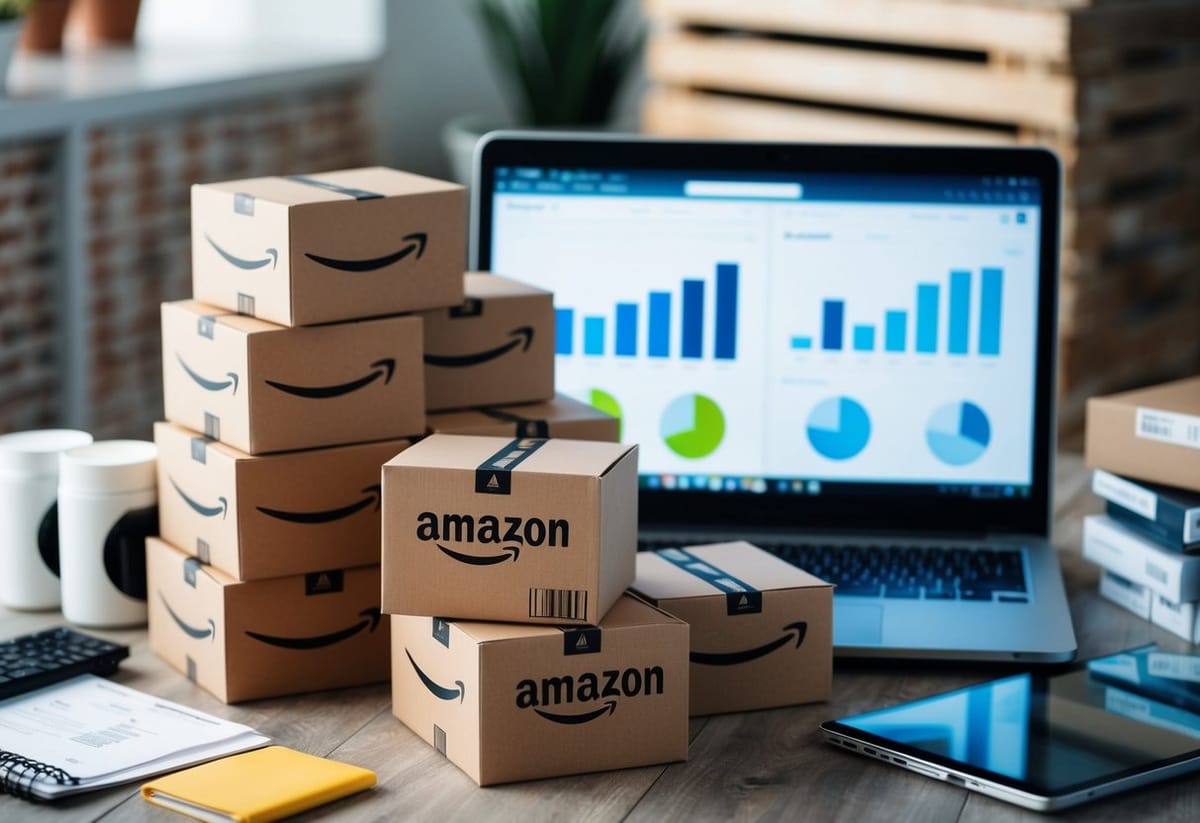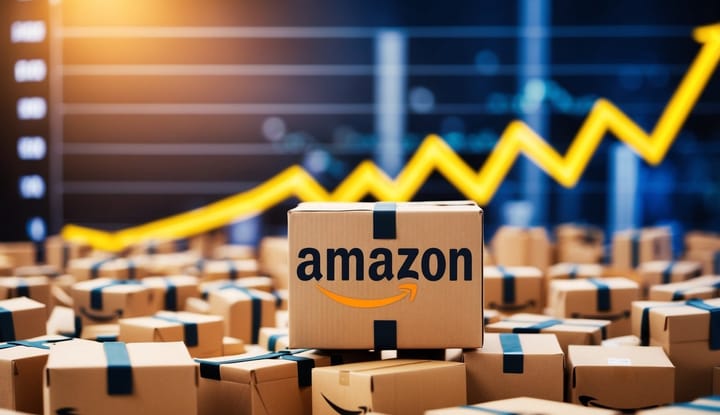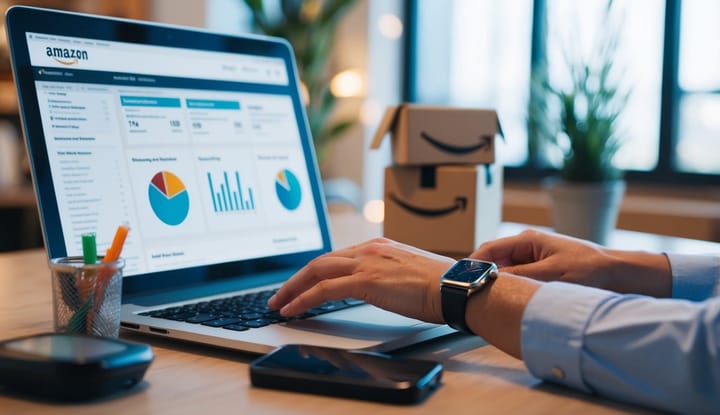Is Amazon FBA Right for You? Pros and Cons for New Sellers

Starting an Amazon FBA business can be an exciting venture for entrepreneurs. Amazon's Fulfillment by Amazon program lets sellers tap into a massive customer base and benefit from the company's trusted reputation. Selling through FBA can be profitable, with 82% of third-party sellers using the service to fulfill orders.
Amazon FBA handles the storage, packing, and shipping of products. This frees up time for sellers to focus on other parts of their business. The program also offers Prime shipping, which can attract more customers and boost sales.
Getting started with FBA involves sending products to Amazon's warehouses. The company then takes care of the rest. This can be a good option for both new and experienced sellers looking to grow their online retail business.
Key Takeaways
- Amazon FBA gives sellers access to millions of customers and Prime shipping benefits
- The program handles storage, packing, and shipping, saving sellers time and effort
- FBA can be profitable, but requires careful planning and product selection
Understanding Amazon FBA
Amazon FBA is a service that lets sellers use Amazon's vast network to store and ship products. It makes selling online easier for businesses of all sizes.
What is Amazon FBA?
FBA stands for Fulfillment by Amazon. It's a service where Amazon handles storage, packing, and shipping for sellers. Sellers send their items to Amazon warehouses. When a customer buys something, Amazon ships it out.
FBA helps sellers reach more customers. It gives them access to Amazon Prime shipping. This can boost sales and save time. Sellers don't have to worry about storing items or mailing packages.
How Does Fulfillment by Amazon Work?
The FBA process is simple. Sellers list their products on Amazon. They then send inventory to Amazon's fulfillment centers. These are big warehouses spread across the country.
When an order comes in, Amazon staff pick the item. They pack it and ship it to the customer. Amazon also handles customer service and returns. This frees up sellers to focus on other parts of their business.
FBA isn't free. Sellers pay fees for storage and fulfillment. But many find the benefits worth the cost. It can help them grow their business on the Amazon marketplace.
Getting Started with Amazon FBA
Starting an Amazon FBA business involves a few key steps. Sellers need to set up their account, pick a selling plan, and learn to use Seller Central.
Setting Up an Amazon Seller Account
To begin selling on Amazon FBA, create a seller account. Go to Amazon's website and click "Sell products with us." Choose between an Individual or Professional account. Provide your business name, address, and tax info. You'll need a bank account and credit card for payments.
Amazon may ask for extra details to verify your identity. This can include a government ID or business documents. Once approved, you can start listing products and using FBA services.
Choosing a Selling Plan
Amazon offers two main selling plans: Individual and Professional. The Individual plan costs $0.99 per item sold. It's good for sellers with less than 40 items per month. The Professional plan has a monthly fee of $39.99. It's better for larger sellers.
Professional sellers get extra tools. These include bulk listing and reporting features. They can also sell in more categories. Think about your sales volume and goals when picking a plan.
Navigating Seller Central Account
Seller Central is the hub for managing your Amazon business. Here, you can list products, track inventory, and handle orders. The dashboard shows sales data and customer feedback.
To list a product, click "Add a Product" and enter details. For FBA, select "Send/Replenish Inventory" to ship items to Amazon. Use the "Reports" tab to check sales and finances. The "Help" section offers guides and support if you get stuck.
Practice using Seller Central's tools. This will help you run your FBA business smoothly. Take time to explore each feature and learn how it can help your sales grow.
Building Your Amazon FBA Business
Starting an Amazon FBA business involves several key steps. This section covers the main aspects of building your FBA venture, from selecting products to optimizing your listings.
Product Research and Selection
Choosing the right products is crucial for FBA success. Use tools like Jungle Scout to find items with high demand and low competition. Look for products with a Best Sellers Rank under 5,000 in the main category.
Check sales trends and seasonality. Aim for items priced between $15-$50 with good profit margins. Consider product size and weight, as these affect shipping costs.
Analyze customer reviews of similar products to spot improvement opportunities. This can help create a better version of existing items.
Private label products often work well for FBA. These allow sellers to build their own brand and stand out from competitors.
Sourcing and Manufacturing
Once a product is chosen, it's time to find suppliers. Many FBA sellers use Alibaba to connect with manufacturers, especially in China. Request samples from multiple suppliers to compare quality.
Negotiate prices, minimum order quantities, and payment terms. Factor in all costs like shipping, customs, and Amazon fees when calculating profitability.
Build strong relationships with suppliers. Good communication helps ensure consistent product quality and timely delivery.
Consider working with a sourcing agent for help navigating international manufacturing. They can assist with quality control and logistics.
Creating Your Product Listing
A compelling product listing is key to attracting customers. Start with a clear, descriptive title that includes important keywords. Use all available character space.
Write detailed bullet points highlighting the product's main features and benefits. Address common customer questions and pain points.
Create high-quality images that showcase the product from multiple angles. Include lifestyle photos and infographics to provide more information visually.
Write a thorough product description. Break it into short paragraphs and use formatting to improve readability. Include all relevant details about materials, dimensions, and usage.
Optimizing for Amazon SEO
Amazon SEO helps products appear in search results. Research relevant keywords using tools like Merchant Words. Include these naturally in the title, bullet points, and description.
Use backend search terms to add more keywords without cluttering the visible listing. These help Amazon's algorithm understand what the product is about.
Encourage customer reviews, as they boost search rankings. Follow up with buyers to ask for feedback. Address negative reviews promptly and professionally.
Consider using Amazon's advertising options to increase visibility. Sponsored Products ads can help new listings gain traction and appear for competitive search terms.
The Financial Aspects

Starting an Amazon FBA business involves several key financial considerations. These include managing fees, understanding revenue streams, and controlling inventory costs.
Managing Amazon FBA Fees
Amazon charges various fees for using their FBA service. Sellers pay a referral fee, which is a percentage of the item's sale price. This fee varies by product category.
FBA fees cover fulfillment costs like packing, handling, and shipping. These fees depend on the size and weight of the product.
Storage fees apply to items kept in Amazon's warehouses. Rates are higher during peak seasons like the holidays.
Long-term storage fees kick in for items stored over 365 days. These can add up quickly for slow-moving inventory.
Understanding Revenue and Profit Margins
Revenue comes from product sales on the Amazon platform. Sellers set their own prices, but must account for all costs.
Profit margins vary widely depending on the product and competition. Some items may have high sales volume but low margins.
Using Amazon's revenue calculator helps estimate potential profits. It factors in all fees and costs associated with selling.
Successful FBA sellers often aim for profit margins of 20-30% after all expenses. This can take time and experimentation to achieve.
Inventory Management and Storage Costs
Effective inventory management is crucial for controlling costs. Overstocking ties up capital and increases storage fees.
Understocking can lead to lost sales and hurt search rankings. Sellers must balance having enough stock without excess.
Creating efficient shipping plans can reduce costs. Sending full truckloads to Amazon's warehouses is often cheaper than partial shipments.
Seasonal products require careful planning. Sellers must time inventory arrivals to avoid long-term storage fees.
Regular inventory reviews help identify slow-moving items. These can be removed or discounted to avoid ongoing storage costs.
Maximizing Growth and Maintaining Customer Satisfaction

Growing an Amazon FBA business requires a focus on customer satisfaction and smart use of Amazon's tools. Sellers can boost sales and build loyalty through strategic approaches.
Leveraging Amazon Prime and Subscription Services
Amazon Prime offers FBA sellers a huge advantage. Prime members get fast, free shipping on eligible items. This can lead to more sales for sellers.
Subscribe & Save is another useful service. It lets customers set up regular deliveries of products they use often. This can create steady income for sellers.
To make the most of these services:
- Ensure products meet Prime eligibility requirements
- Offer competitive prices on Subscribe & Save items
- Use clear product titles and images to attract Prime members
Handling Returns and Customer Service
Good customer service is key to success on Amazon. Quick responses to questions and fair return policies build trust.
Tips for managing returns and customer service:
- Set clear return policies
- Process refunds promptly
- Use Amazon's automated customer service tools
- Respond to customer messages within 24 hours
Packaging also plays a role in customer satisfaction. Use sturdy boxes and proper cushioning to prevent damage during shipping.
Expanding Your Reach with TikTok and Instagram Influencers
Social media can help FBA sellers reach new customers. TikTok and Instagram are popular platforms for product promotion.
Ways to work with influencers:
- Find influencers whose followers match your target audience
- Offer free products in exchange for honest reviews
- Create unique discount codes for influencers to share
- Ask influencers to demonstrate your product in use
This strategy can increase brand awareness and drive traffic to your Amazon listings. It's a good way to stand out in a crowded marketplace.
Frequently Asked Questions

Many people have questions about starting an Amazon FBA business. Here are answers to some common queries about getting started, profitability, investments, success rates, income potential, and challenges.
What are the initial steps for beginners interested in starting Amazon FBA?
New sellers should create an Amazon seller account and choose products to sell. Research popular items and find reliable suppliers. Set up product listings with good descriptions and photos. Ship inventory to Amazon's warehouses.
What level of profitability can be expected from engaging in Amazon FBA?
Profits vary widely based on products, competition, and sales volume. Some sellers make a few hundred dollars per month, while others earn six figures annually. It often takes time to become profitable.
How much initial investment is typically necessary for launching an Amazon FBA business?
Most sellers start with $500 to $3000 for inventory and supplies. Costs can be higher for premium products. Ongoing expenses include Amazon fees, inventory restocking, and advertising.
What is the success rate for new sellers using Amazon FBA?
Success rates are hard to measure. Many new sellers quit within the first year. Those who persist and adapt their strategies have better chance of building a profitable ecommerce business over time.
Can individuals really earn significant income through the Amazon FBA program?
Some sellers do earn substantial income through FBA. It requires hard work, smart product choices, and effective marketing. Most successful sellers treat it as a full-time business.
What are the common challenges faced by new Amazon FBA sellers?
New sellers often struggle with product selection, pricing, and inventory management. Standing out in a crowded marketplace is tough. Learning Amazon's rules and best practices takes time.
Ready to Start Selling on Amazon—Smart and Simple?
Join our mini-course at WAH Academy and get real guidance on choosing your first product, crunching the numbers, and setting up your seller account—without the overwhelm.
No hype. No fluff. Just clear steps to get you moving.
Tap the button and kick off your Amazon journey today.



